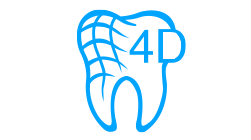TMJ Dysfunction
TMJ Dysfunction

At DIA, our esteemed Prosthodontist, Professor Vasilios Chronopoulos, offers dynamic treatment options to address and treat TMJ dysfunction and disorders.
What is TMJ Dysfunction?
TMJ Dysfunction refers to a disorder affecting the temporomandibular joint (TMJ).
The TMJ connects the lower jaw (mandible) to the skull, located in front of each ear. Its primary function is to facilitate the movement of the jaw, allowing you to:
- Open and close the mouth – for speaking, eating, yawning, and breathing.
- Move the jaw side-to-side – essential for chewing and grinding food.
- Move the jaw forward and backward – for proper teeth alignment and jaw movement.
The TMJ is a complex joint that combines a hinge action with sliding motions, enabling smooth and coordinated movements. It’s supported by muscles, ligaments, and a cartilage disc that absorbs shock and ensures the joint moves smoothly.
TMJ Dysfunction occurs when there are issues with the joint or surrounding muscles, causing pain and limited or impaired function.
Common Causes of TMJ ?
TMJ Dysfunction can be caused by a variety of factors, including:
- Jaw injury or trauma: Direct impact to the jaw or face can damage the TMJ.
- Bruxism (teeth grinding): Grinding or clenching the teeth puts extra strain on the jaw muscles and joint.
- Arthritis: Osteoarthritis or rheumatoid arthritis can affect the TMJ, leading to inflammation of the joint, stiffness and pain.
- Poor posture: Particularly in the neck and upper back, poor posture can affect the alignment of the jaw.
- Stress: High levels of stress can lead to clenching or tightening of jaw muscles, worsening TMJ problems.
Symptoms of TMJ Dysfunction?
Symptoms of TMJ Dysfunction can vary from mild discomfort to severe pain and may include:
- Jaw pain or tenderness
- Pain in or around the ear
- Difficulty chewing or discomfort while chewing
- Locking of the jaw or limited range of motion
- Clicking, popping, or grating sounds when opening/closing the jaw
- Headaches or facial pain
How TMJ Dysfunction is Diagnosed?
TMJ Dysfunction is diagnosed through a combination of medical history review, physical examination, and possibly imaging tests. A dentist or healthcare provider may:
- Ask about symptoms and lifestyle factors (like stress or grinding).
- Examine the jaw for clicking sounds or limited movement.
- Feel the joint and muscles for pain or tenderness.
- Recommend imaging tests like X-rays, CT scans, or MRI to get a detailed view of the jaw and TMJ structures.

Treatment Options for TMJ Dysfunction
Treatment for TMJ Dysfunction varies depending on the severity of symptoms and underlying causes. Both non-surgical and surgical treatments are available to relieve pain and improve jaw function.
Non-Surgical Treatments:
Non-surgical treatments are often the first line of defense for TMJ Dysfunction, including:
- Medications: Pain relievers, anti-inflammatories, or muscle relaxants can alleviate discomfort and reduce muscle tension.
- Physical therapy: Exercises to strengthen jaw muscles, improve posture, and relax the jaw can be helpful.
- Oral splints or mouthguards: Worn at night, these can prevent teeth grinding and reduce strain on the TMJ.
- Lifestyle changes: Reducing stress, avoiding hard or chewy foods, and improving posture can help relieve symptoms.
- Dry needling or acupuncture: These techniques can help release muscle tension and alleviate pain in the jaw and surrounding areas.
Surgical Treatments:
In cases where non-surgical treatments are ineffective, surgical intervention may be necessary, such as:
- Arthrocentesis: A minimally invasive procedure where fluid is injected into the joint to reduce inflammation.
- TMJ arthroscopy: A small incision is made, and an arthroscope is used to treat the joint directly.
- Open-joint surgery: In severe cases, more invasive surgery may be required to repair or replace parts of the TMJ.
- Jaw realignment surgery: In some cases, corrective jaw surgery (orthognathic surgery) may be recommended to improve the alignment of the jaw and relieve TMJ symptoms.
Preventing TMJ Issues
Preventing or eliminating TMJ issues involves a combination of lifestyle adjustments, at-home care, and sometimes professional treatments.
TMJ disorders can be triggered by various factors, including stress, teeth grinding, or injury to the jaw. Here are strategies to help prevent or manage TMJ problems:
Manage Stress and Anxiety
- Stress Reduction Techniques: Stress is a common trigger for TMJ issues, as it often leads to teeth clenching or grinding
Prevent Teeth Grinding (Bruxism)
- Mouthguards: If you grind your teeth, especially during sleep, a custom nightguard can protect your teeth and reduce the pressure on your jaw joint. These guards cushion the teeth and prevent further damage to the TMJ.
- Mindfulness: During the day, pay attention to habits like clenching your teeth, especially when stressed. Try to keep your teeth slightly apart when the jaw is at rest, with the tongue resting at the roof of the mouth.
Jaw Exercises and Stretches
- Jaw Strengthening: Gentle jaw exercises can strengthen the muscles around the joint and improve mobility. A healthcare provider or dentist can recommend specific exercises to help relieve tension and align the jaw correctly.
- Stretching and Relaxation: Regularly stretch and massage your jaw, neck, and shoulders to release muscle tension and improve flexibility.
Heat and Cold Therapy
- Cold Compresses: If you experience pain or swelling in the jaw area, applying cold packs for 10-15 minutes can help reduce inflammation and numb the pain.
- Heat Therapy: Use warm compresses to soothe sore jaw muscles and increase blood flow, which can promote healing and relaxation.
Professional Treatments
- Physical Therapy: A physical therapist can guide you through exercises and manual therapy techniques to improve jaw mobility and reduce tension.
- Orthodontic or Dental Care: Misaligned teeth or bite issues can contribute to TMJ disorders. Corrective treatments like braces or bite adjustment procedures may help alleviate symptoms.
- Botox Injections: In some cases, Botox injections may be recommended to relax overactive jaw muscles and relieve TMJ pain.
Regular Dental Checkups
- Regular dental visits can help identify early signs of TMJ disorders or other dental issues that may lead to jaw pain. Your dentist can offer preventive treatments, such as custom mouthguards or orthodontic interventions, to help you avoid developing TMJ problems.



















